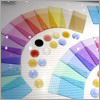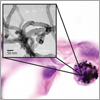|
|
|
Surfactants Self-assemble Nanoparticles
 By mixing block copolymers and nanoparticles with surfactants, Lawrence Berkeley Laboratory scientists coaxed the nanoparticles to self-assemble into 1D, 2D, and 3D arrays. For fine positioning, they added external stimulation — depending on the type of surfactant used, the nanoparticles can be shifted with either light or heat.
By mixing block copolymers and nanoparticles with surfactants, Lawrence Berkeley Laboratory scientists coaxed the nanoparticles to self-assemble into 1D, 2D, and 3D arrays. For fine positioning, they added external stimulation — depending on the type of surfactant used, the nanoparticles can be shifted with either light or heat.
|
Nanowires Convert to Nanostructures
 Cation-exchange reactions can convert cadmium-sulfide nanowires into a range of zinc cadmium sulfide nanostructures, such as patterned nanoscale strips, nanowires, and hollow semiconducting nanotubes. The process is size dependent — the reaction rates for sub-nanometer nanocrystals are too fast to control and the rates for bulk materials are too slow. The 5 to 200 nm regime is the sweet spot at which the process works best.
Cation-exchange reactions can convert cadmium-sulfide nanowires into a range of zinc cadmium sulfide nanostructures, such as patterned nanoscale strips, nanowires, and hollow semiconducting nanotubes. The process is size dependent — the reaction rates for sub-nanometer nanocrystals are too fast to control and the rates for bulk materials are too slow. The 5 to 200 nm regime is the sweet spot at which the process works best.
|
|
|
|
It's Snowing Nanoparticles
 Solution rich in gold ions will grow 150 to 500 nm gold nano-snowflakes on graphene substrates, Kansas State University engineers have shown. By adjusting the rate of diffusion and catalytic reduction, the group produced snowflakes with varying degrees of dendritic features, as well as varying size and coverage density. The interface of nano-snowflake with the graphene reduces the Schottky barrier from 126 to 56 meV and cuts the bandgap nearly in half.
Solution rich in gold ions will grow 150 to 500 nm gold nano-snowflakes on graphene substrates, Kansas State University engineers have shown. By adjusting the rate of diffusion and catalytic reduction, the group produced snowflakes with varying degrees of dendritic features, as well as varying size and coverage density. The interface of nano-snowflake with the graphene reduces the Schottky barrier from 126 to 56 meV and cuts the bandgap nearly in half.
|
Nanotech Powers Up Fuel Cells
 One-dimensional pores in a metal-organic framework can conduct protons, showing the material's potential as a gas separator. Canadian researchers lined the pores with sulfonate groups that modulate the conduction process. In experiments, a sample gas-separator membrane demonstrated gas-tight performance. The work could lead to higher efficiency, lower cost fuel cells.
One-dimensional pores in a metal-organic framework can conduct protons, showing the material's potential as a gas separator. Canadian researchers lined the pores with sulfonate groups that modulate the conduction process. In experiments, a sample gas-separator membrane demonstrated gas-tight performance. The work could lead to higher efficiency, lower cost fuel cells.
|
|
|
 |
Titanate Nano Powders (Barium,
Strontium Titanate)
TPL, Inc.
 TPL offers a range of titanate powders with controlled size and chemistry. The nano-size powders are produced via an aqueous, low temperature process that allows for binary and tertiary oxide compositions with controlled stoichiometries. The particle sizes (50 to 400 nm) are ideal for ultra-thin dielectric layers in composites and ceramic capacitors.
TPL offers a range of titanate powders with controlled size and chemistry. The nano-size powders are produced via an aqueous, low temperature process that allows for binary and tertiary oxide compositions with controlled stoichiometries. The particle sizes (50 to 400 nm) are ideal for ultra-thin dielectric layers in composites and ceramic capacitors. |
BioSpec-nano UV Spectrophotometer
Shimadzu Scientific Instruments, Inc.
 Shimadzu's BioSpec-nano is a dedicated spectrophotometer for the quantitation of nucleic acids. Life Science researchers can conserve precious samples and obtain accurate and reproducible results made possible by an automated precision drive mechanism. More details available here.
Shimadzu's BioSpec-nano is a dedicated spectrophotometer for the quantitation of nucleic acids. Life Science researchers can conserve precious samples and obtain accurate and reproducible results made possible by an automated precision drive mechanism. More details available here. |
|
|
|
Gold Dipole Antennas Transmit Light
 Using electron-beam lithography, researchers at the Karlsruhe Institute of Technology have produced arrays of gold dipole nanoantennas suitable for acting as optical transmitters. The 70 to 300 nm long antennas provide a 100,000 GHz frequency response. Applications include communications and optical microscopy.
Using electron-beam lithography, researchers at the Karlsruhe Institute of Technology have produced arrays of gold dipole nanoantennas suitable for acting as optical transmitters. The 70 to 300 nm long antennas provide a 100,000 GHz frequency response. Applications include communications and optical microscopy.
|
Asymmetric Molecule Forms Diode
 Asymmetric molecules provide one-way current flow to form a molecular diode. Scientists at Arizona State University covalently bound non-symmetric diblock dipyrimidinyldiphenyl molecules using selective deprotection to orient the molecules and AC modulation of the electrode gap to characterize them.
Asymmetric molecules provide one-way current flow to form a molecular diode. Scientists at Arizona State University covalently bound non-symmetric diblock dipyrimidinyldiphenyl molecules using selective deprotection to orient the molecules and AC modulation of the electrode gap to characterize them.
|
Manufacturing & Commercialization . . . |
 |
| Learn More |
|
|
Superacid Dissolves CNTs
 Carbon nanotubes (CNTs) dissolve spontaneously in chlorosulfonic acid for fluid-phase assembly, Rice University researchers report. The nanotubes self-align when in the solution, allowing the CNTs to form liquid-crystal phases, then form fibers. The process can be scaled up for volume manufacturing, providing a method for industrial-scale production.
Carbon nanotubes (CNTs) dissolve spontaneously in chlorosulfonic acid for fluid-phase assembly, Rice University researchers report. The nanotubes self-align when in the solution, allowing the CNTs to form liquid-crystal phases, then form fibers. The process can be scaled up for volume manufacturing, providing a method for industrial-scale production.
|
Stir it Up, Little Nanoparticle
 With a new technique dubbed vortex-field mixing, researchers at Sandia National Laboratories can homogenize nanovolumes in microchannels like those found in lab-on-a-chip applications. Under a vortex magnetic field with a 55 degree field angle, magnetic nanoparticles suspended in solution form chains that act to stir the solution. Once the fluid is mixed, the particles are magnetically removed. Be sure to watch the video.
With a new technique dubbed vortex-field mixing, researchers at Sandia National Laboratories can homogenize nanovolumes in microchannels like those found in lab-on-a-chip applications. Under a vortex magnetic field with a 55 degree field angle, magnetic nanoparticles suspended in solution form chains that act to stir the solution. Once the fluid is mixed, the particles are magnetically removed. Be sure to watch the video.
|
|
|
 |
Nano Linear NT...H
IKO International, Inc.
 Nano Linear NT...H is a direct drive moving magnet type positioning table. Magnets and an optical linear scale are incorporated in a moving table made of steel, and stator coils and linear scale head incorporated in a steel bed. Mechanical contact is completely eliminated except linear motion rolling guides. From IKO International, Inc.
Nano Linear NT...H is a direct drive moving magnet type positioning table. Magnets and an optical linear scale are incorporated in a moving table made of steel, and stator coils and linear scale head incorporated in a steel bed. Mechanical contact is completely eliminated except linear motion rolling guides. From IKO International, Inc. |
NOTIO™ Nano-crystal Structure
Controlled Elastomer
Mitsui Chemicals America, Inc.
 NOTIO™ from Mitsui Chemicals America, Inc. is a flexible, low density, transparent elastomer that can be used as a modifier for other compounds, achieving a balance of impact resistance, scratch resistance, heat resistance, transparency, flexibility and elasticity, and elimination of whitening upon bending. NOTIO™ enables the development of higher-value, better functioning products.
NOTIO™ from Mitsui Chemicals America, Inc. is a flexible, low density, transparent elastomer that can be used as a modifier for other compounds, achieving a balance of impact resistance, scratch resistance, heat resistance, transparency, flexibility and elasticity, and elimination of whitening upon bending. NOTIO™ enables the development of higher-value, better functioning products.
|
Careers & Commentary . . . |  |
|
Nano to Weather Economic Storm?
 The nanotech and MEMS markets are likely to weather the economic storm, but the semiconductor industry, to which they are inextricably bound, may not be so lucky, says Small Times editor Pete Singer. Read his assessment to gain a better understanding of what comes next.
The nanotech and MEMS markets are likely to weather the economic storm, but the semiconductor industry, to which they are inextricably bound, may not be so lucky, says Small Times editor Pete Singer. Read his assessment to gain a better understanding of what comes next.
|
|
Nanotech Repels Ice
 Coatings of superhydrophobic nanoparticles can prevent the buildup of freezing rain on power lines, roads, and more. University of Pittsburgh scientists combined silica nanoparticles with silicone-resin solution to create a surface with minute ridges that prevents ice from binding. They obtained the best results from sub-50 nm particles. Watch the video of ice not forming — much more interesting than watching paint dry.
Coatings of superhydrophobic nanoparticles can prevent the buildup of freezing rain on power lines, roads, and more. University of Pittsburgh scientists combined silica nanoparticles with silicone-resin solution to create a surface with minute ridges that prevents ice from binding. They obtained the best results from sub-50 nm particles. Watch the video of ice not forming — much more interesting than watching paint dry.
|
Share Your Thoughts . . . About This Month's Topic
 Is Cheating a Matter of Choice or Biology?
Is Cheating a Matter of Choice or Biology?
Is honesty part of our character or encoded into our brain?

|
|
|
|
|
|


















